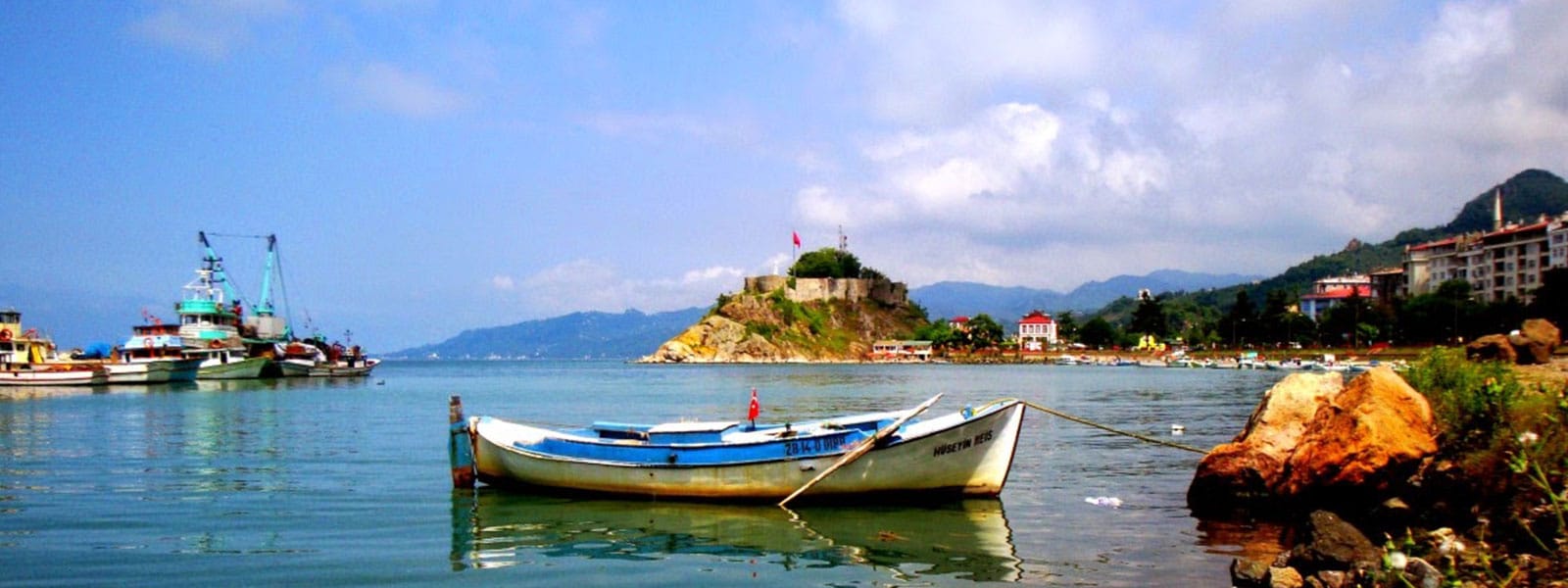
GIRESUN
I looked out from Giresun Castle on the peninsula. Enchanted by the sight of the town in the glowing light of the late afternoon, I scanned the view in every direction. The castle was filled with people strolling, picnicking, seated in the tea gardens watching the sea and the town, and children playing. It is thought that the castle may originally have been built by King Pharnakes I of Pontus in the 2nd century BC. Although some of its walls are today in ruins, it is still magnificent. At its highest point is the monumental tomb of Topal Osman, commander of Ataturk’s first guard regiment. Giresun Island appears tiny from this high vantage point. Traces can be seen of the ancient walls which once ran in a square around the island, and of the Monastery of St Phocas, Archbishop of Sinop.
The island, anciently known as Aretias, is associated with the legend of the Golden Fleece, in search of which Heracles and the other Argonauts sailed through the Black Sea. After numerous adventures, they arrived at Aretias, where they thought the Golden Fleece was concealed. Here dragon-like birds with brazen claws, teeth, and wings which had settled on the island after Heracles had driven them from Lake Stymphales attacked the Argonauts, one of whom was killed. The Argonauts defeated the birds but failed to find the Golden Fleece. Fortunately, the birds which inhabit the island today are perfectly harmless. Giresun Island is commemorated every year in May at the Aksu Festival, a tradition thought to date back three thousand years.
It is held opposite the island at the mouth of the Aksu River where it pours into the Black Sea. Early in the morning, local people gather here to perform an ancient ritual which consists of passing an enormous hoop trivet down over each person who then steps out over the rim. This is repeated three times, after which they stand with their backs to the sea and throw seven pairs of stones and one single stone. Finally, the participants circle the island in boats (formerly rowing boats but today motor boats). This venerable ritual represents the reawakening of the soil and fertility, driving away evil spirits with the coming of spring, and celebrating the sanctity and perpetuation of the hearth as a symbol of the family.
Giresun is a corruption of the ancient name Kerasion or Kerasus, meaning City of Cherries, from the Greek word for cherry, kerasi. The cherry tree was a native of Giresun, and from here carried to countries all over the world. In celebration of the cherry trees origin, the Japanese city of Saga declared Giresun to be its twin city. Exchange visits are frequent, and Giresun participates in Saga’s annual cherry festival. However, the main crop today is not cherries but hazelnuts. From the coast up to a height of 800 m. all the hillsides are planted with hazelnut groves producing the world’s finest quality hazelnuts.
From spring until the end of August conversation in Giresun centers around the nuts, which have become so much a part of the local culture that there are riddles, stories, and songs about them. In one local folk song, a lover declares, ‘My darling, not even a hazelnut / Would I eat without you’.
Maize, cabbages, green beans, and other vegetables are grown in everyone's gardens. No meal in Giresun is complete without cabbage, which is made into soup and numerous other dishes and served with cornbread. Nettle stew and pickled beans are among the other specialties of the local cuisine. Last but not least are anchovies, which are the most popular fish throughout the Black Sea region and cooked in myriad ways.
Anchovies are no longer found in their former abundance, however, and it is to be hoped that they do not disappear altogether, like Giresun’s enormous horse mackerel. When I saw these fish in an old photograph I refused to believe that they were horse mackerel until convinced by the accounts of some elderly people. These fish, equal in size to bonito, have not been seen for the past thirty years.
The historic quarter of Giresun, with its old houses clustered around the castle, was declared a grade one conservation site in 1981. In particular, the area known as Zeytinlik is a picturesque place of stone and timber houses with gardens. One of the two 18th century churches in the city center is now a museum, and the other, a Gothic-style Catholic church, houses a children's library. The mosques and public buildings, mostly dating from the 19th century, include Kale Mosque, Kapu Mosque, Haci Mikdat Cekek Mosque, and Government House. The province of Giresun has the second highest rainfall averages in Turkey, which explains the lush green vegetation which covers the landscape from the seashore up to the mountain peaks.
The province is also famous for its natural mineral water and spectacular mountainous hinterland, with its many rivers, valleys and high meadows. The mountain pastures of Kulakkaya, Kumbet, and Bektas now have accommodation for overnight visitors who want to enjoy a peaceful break far from the city in the midst of unspoiled nature. As I wandered through Giresun I recalled an anecdote related by Yusuf Ziya Ortac. In the 1950s Israel’s Foreign Ministry advisor Ezra Danin was touring Turkey. Late one night in Giresun he was looking out of his window at the full moon reflected on the Black Sea, and it was so beautiful that he telephoned a friend who was serving as ambassador in Ankara. His friend had been asleep and answered the phone in consternation, only to hear Danin say, ‘Do you know why I woke you up? To tell you that I have found the paradise described in the holy scriptures!’
